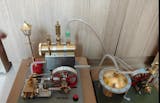
TECHING F135 Fighter Turbofan Engine Kit Small-content-ratio Twin-rotor Axial-flow Pressurized Turbofan Engine Model
Prototype engine application background:
F135 turbofan engine (installed in the US F-35 stealth fighter)
The F135 is an afterburning turbofan engine developed by the US Pratt & Whitney Company, with a maximum thrust of more than 18 tons (40,000 pounds). The F135 engine is developed based on the core engine and main structure of the F-22's F119 engine. Since the F-35B that the Marine Corps and the British Royal Navy are expected to adopt must be able to take off and land vertically, the F135 can also be equipped with a downward-bending three-bearing rotating nozzle. However, this nozzle is only used in vertical take-off and landing situations, which can greatly shorten the take-off/landing distance. Other F-35s do not use this design.

reference physical model

engine model
The F135 turbofan engine comes in three different models:
The F135-PW-100 engine is installed on the F-35A Air Force take-off and landing fighter - conventional take-off and landing (CTOL)
The F135-PW-400 engine is installed on the F-35C Navy carrier-based fighter - carrier-based (CV)
The F135-PW-600 engine is installed on the F-35B Marine Corps short take-off/vertical landing fighter - short take-off and landing (STOVL)
Components of the F135 turbofan engine:
3-stage fan, 6-stage compressor, aerodynamic nozzle, annular combustion chamber, single-stage high-pressure turbine and 2-stage low-pressure turbine, afterburner, two-dimensional vector nozzle, etc.

reference structure diagram
Structural features of this model (structural layout from front to back):
1st stage fan, 2nd stage low pressure compressor, 6th stage high pressure compressor, 1st stage high pressure turbine, 2nd stage low pressure turbine. It adopts floating wall flame tube annular combustion chamber, central double shaft structure, and high and low pressure turbines rotate in opposite directions.

model structure of the engine
The F135 turbofan engine is a derivative of the F119 turbofan engine, both of which are axial-flow engines.
The F135 uses the core engine of the F119, with an efficient 6-stage high-pressure compressor, a 1-stage high-pressure turbine and an efficient fan (driven by a 2-stage low-pressure turbine). The F135 uses the BAE Systems Full Authority Digital Engine Control System (FADEC). In order to improve the reliability and maintainability of the engine, the F135 uses a large number of field replaceable components (LRC), and the number of parts is reduced by about 40% compared to the F119.
(The components of the F119 engine: a 3-stage fan, a 6-stage high-pressure compressor, an annular combustion chamber with aerodynamic nozzles and floating wall flame tubes, a single-stage high-pressure turbine, a single-stage low-pressure turbine with the opposite direction of the high-pressure turbine, an afterburner and a two-dimensional vector nozzle.
The entire engine is divided into 6 units: fan, core engine (high-pressure compressor + annular combustion chamber + high-pressure turbine), low-pressure turbine, afterburner, tail nozzle and accessory transmission case, in addition to accessories, FADEC and engine monitoring system.)
In order to improve the thrust, the air flow and bypass ratio of the engine are increased, and the operating temperature of the engine is increased; in order to obtain short-distance take-off and vertical landing capabilities, the vertical take-off and landing type adds a novel lift fan, a three-bearing rotating nozzle, and a roll control nozzle. Its three-stage fan adopts an ultra-medium aspect ratio, forward-swept blades, an integral blade disk with linear friction welding, and detuning technology. While maintaining the high-level pressure ratio, high efficiency, large surge margin and light weight of the original fan, the cross-sectional area of the fan is increased by 10%-20%. The six-stage compressor is basically the same as the F119 engine. The F135 turbofan engine has a thrust-to-weight ratio of more than 10, a compression ratio of more than 28, and a maximum thrust of more than 18 tons. It is currently the fighter turbofan engine with the largest thrust, and is mainly used in the most advanced fifth-generation fighters.
F135 turbofan engine technical advantages:
- Three-dimensional pneumatic compressor design, the most efficient way to improve intake efficiency
- Advanced combustion organization technology, so that the fuel is fully burned, reducing fuel consumption and emissions
- Single crystal turbine blades, strong resistance to high temperatures
- Ceramic-based composite casing, high temperature and corrosion resistance, reduced weight
- Equipped with a full authority digital electronic control system (FADEC) to ensure that the engine is always in the best working condition
- Modular design, manufacturing and assembly, simple operation and convenient maintenance

The F135 turbofan engine is also one of the best fighter engines in the world.
The top 10 fighter engines of Western countries ranked by engine thrust are as follows (for reference only):

Three typical fifth-generation fighter jets and engines in the world:
- The US F-35 stealth fighter, equipped with an F135 engine

- Russia's T-50 (SU57) stealth fighter, equipped with AL-41 engine

- China's J-20 stealth fighter, equipped with WS-15 engine




Einen Kommentar hinterlassen